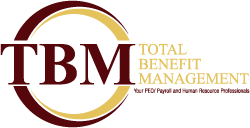- Total Benefit Management

6 Tips for Hearing Tough Feedback
September 17, 2019
4 Reasons Informed Employees Are Happy Employees
September 24, 2019This article comes from Entrepreneur.
How to Write An Unforgettable Company Mission Statement
You can find lots of mission-statement templates online, and as helpful as those may (or may not) be, they don’t really explain what you truly need to know, i.e. how do you write an amazing one of your own?
What makes up an unforgettable mission statement?
The best mission statements generally meet four criteria:
- Above all, it should inspire you and your team. This means it packs a surprising emotional wallop.
- It should be succinct. Great mission statements are not only brief but packed. In short, they convey a lot of information in a finite amount of space. Aim for two-to-four sentences totaling about 100 words or fewer.
- It should be timeless, living well past the initial launch frenzy. Think “evergreen.” it doesn’t have to last forever, but typically, great mission statements don’t often get radically changed.
- Finally, it should reflect your company’s core values and purpose. The thing that drives your company (and you) to succeed should be reflected in the core of your statement. It will impact company culture, decision-making, and business strategy.
So how do you go about creating your company’s mission statement? Stick to these five rules of thumb:
1. Address your key stakeholders.
Begin with your audience. In order, the most important stakeholders for your mission statement are:
- Your customers and prospects.
- Your employees.
- Your investors.
In spreading the message about what you do, why you do it and who you do it for, your statement needs to speak to each of these groups. Customers want to know what distinguishes your solutions from all the others at their disposal. Employees want to know what you’re about and where they fit into that mission. And partners and investors need to be reassured that you’re really intent on delivering value.
2. State your purpose.
Why did you start this particular business? What drove you to drop all other forms of gainful employment and choose this particular path. That is, what led you to start this specific company or nonprofit organization from scratch? The answer to that question should form the meat of your mission statement. Start by jotting down a few different phrases to describe that overpowering “why,” and be as specific as possible.
3. Use specific, simple language.
The vague corporate lingo that pervades business culture is wholly out of place when it comes to your mission statement. Instead, look for the right words, which are almost always highly specific, simpler and more colorful than the overused buzzwords we’re all sick of.
If needed, use a thesaurus to pinpoint the precise phrasing that makes your mission statement sing. Read it out loud a few times to friends or other business owners and ask them if it sounds meaningful to them. If they look at you with confused expressions, go back and try again.
4. Infuse it with spirit.
A mission statement should inspire your stakeholders and team members. It should excite the people who are your ideal customers and prospects. If yours is less than motivational, try thinking of it from the perspective of the person listening. Your core audience, as noted above, consists of your customers, employees, and investors. What would make each of these groups sit up a little straighter and nod along in enthusiasm? What’s best about your company? What aspirational goals are your team members excited to strive for and achieve?
Click here to view the original article.

